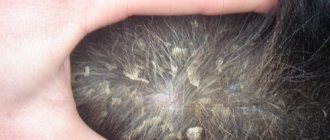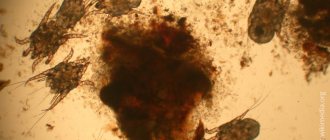The appearance of purulent discharge from the eyes is the main symptom of the inflammatory process. If you don’t find out why your dog’s eyes are festering and don’t start treatment as soon as possible, sepsis will develop. This complication spreads to the bloodstream, so all internal organs and systems are affected.
Reasons why a dog's eyes fester
Pus in a dog’s eye appears due to external irritants or systemic disorders within the body. It is not an independent disease, so to eliminate it it is necessary to find out the root cause.
Severe irritation
In most cases, allergies are to blame for mucosal irritation, but injury can also be a cause. Dust, long hair, smoke, caustic household chemicals and sand can damage the delicate shell. Constantly flowing tears create a moist environment. This attracts pathogenic microorganisms that worsen the pet’s condition.
Conjunctivitis
The most dangerous inflammation of the conjunctiva is purulent, caused by infection. As the disease progresses, the purulent discharge from the dog's eyes changes color to greenish or brownish. A crust forms on the eyes, sticking the eyelids together.
In the chronic course, the mucous membrane swells greatly, narrowing the open eye to the size of a small slit. A sick dog constantly squints, blinks frequently and avoids sunlight.
Trauma or foreign object
Trauma to the eyelid or mucous membrane is caused by one’s own sharp claws and small foreign objects: sand, twigs, pebbles. Your pet can get hurt when playing or fighting with other animals, or when scratching too vigorously. Without timely treatment, the resulting wound turns into an open gate for bacteria.
Early diagnosis of mechanical injuries is very problematic, since exudate does not form immediately. Sometimes the first signs of pathology appear a month after the injury.
If both eyes of a dog are infected, there is a high probability of head damage. In all other cases, discharge is observed only from one eye socket.
Allergy
Allergy symptoms include severe watery eyes, itching, hair loss, redness and swelling. The following allergens can cause a similar reaction:
- food;
- pollen;
- a collar or other item in contact with fur or skin;
- preparations for treatment against parasites;
- reagents that destroy ice and snow;
- skincare cosmetics and household chemicals.
If the cause of the deterioration is a new diet, return to the previous one or try a different brand of food. When the allergen is eliminated, the pet’s condition returns to normal within a couple of days, so you can stop taking medications.
Infection with worms
Parasitic infection is accompanied by severe intoxication caused by the waste products of helminths. Due to itching, the dog constantly scratches, damaging the mucous membranes with its claws. Over time, bacteria penetrate the wounds, causing inflammation. Helminthiasis can be recognized by thick pus that sticks together the eyelids during sleep.
Pathologies of the eyes and eyelids
Congenital ophthalmic pathologies include abnormal growth and location of eyelashes, ectropion, obstruction of the lacrimal duct and other disorders affecting the cornea and eyelid. Due to the accumulation of dirt and tears, pathogenic microflora is formed, which provokes the appearance of chronic conjunctivitis. Those at risk include Shih Tzus, Pekingese, Pugs, Shar-Peis and other breeds with bulging eyes.
Otitis
If your dog's eyes are purulent, check him for otitis media. It is easily identified by ear pain, scabies and frequent head shaking. With this inflammatory disease, pus appears only on the affected side.
Infectious diseases
Another possible cause is viral and bacterial infections. The risk group includes older dogs, puppies and pets with chronic diseases. Some pathologies are transmitted to humans, so you should be very careful when interacting with a sick pet.
The most common pathologies accompanied by purulent discharge include:
- parvovirus enteritis;
- plague;
- chlamydia;
- mycoplasmosis;
- infectious laryngotracheitis and hepatitis.
At the initial stage, the infection resembles a common cold. The dog becomes lethargic, loses appetite, suffers from nausea and diarrhea. More specific signs appear as the disease progresses. If a puppy’s eyes are festering, you need to go to the veterinarian immediately - some infections can kill a fragile baby in 1-2 days.
Problems with internal organs
If an elderly dog's eye becomes infected, then there is a high probability of a systemic failure. It occurs when the body’s defenses are weakened and leads to chronic pathologies of the esophagus, kidneys, intestines, liver and other internal organs. Diabetes mellitus and vitamin A deficiency may also be the cause of the problem.
Prevention
In combination with antihistamine drops, the following preventive measures will help minimize painful sensations in the eyes and generally increase the effectiveness of treatment:
- If you have a desire to touch your itchy and itchy eyes on the street, it is better to use a handkerchief or disposable napkin that you have taken with you in advance;
- Contact lenses cause additional irritation to the mucous membranes of the eyes and increase the symptoms of cold conjunctivitis. Therefore, in the event of an impending exit to the cold, it is better to refuse their use ;
- for women suffering from this disease to completely avoid wearing makeup . This is explained by the fact that cosmetics are likely to get into the eye area and can provoke or intensify inflammation;
- In windy weather, sunglasses will help protect your eyes.
Associated symptoms
If there is a small amount of clear discharge, you don’t have to worry about your pet’s health. The reason for their appearance is accumulated tear fluid. The presence of pathology is indicated only when the color of the discharge changes to yellow-green, grayish or red.
In addition to the color change, you should pay attention to other accompanying symptoms. Depending on the cause, abnormalities can occur not only in the eyes, but also in other organs.
Tumor of the eyelids
Due to constant itching, the animal scratches its eyelids with its paws or by rubbing against surrounding objects. Scratching causes irritation and injury, accompanied by swelling of the eyelids.
Redness
If the proteins are clean, then one or more hemorrhages, characteristic of mechanical damage, can be seen in them. If the irritation is too strong, the entire protein turns red. Redness is accompanied by a burning sensation and profuse lacrimation.
Itching
Untreated wet areas dry out on their own and form crusts. They are accompanied by itching and pain, so the animal constantly tries to relieve the discomfort with the help of its paws.
Deviations not related to the eyes
Deterioration of the condition can be noticed by behavioral changes. A sick pet loses its usual activity, does not follow commands well, avoids communication and refuses its favorite treats. Also, the presence of the disease can be indicated by the appearance of vomiting, fever, unpleasant odor from the ears, bloating, diarrhea or constipation.
Symptoms
Signs of the disease can appear either singly or several at once , sometimes as a whole complex of body reactions to cold. These include :
- Red, watery and itchy eyes;
- Peeling and redness of the skin;
- Swelling in the mouth and visual organs;
- Non-infectious rhinitis - in the cold, a person experiences severe nasal congestion, a large amount of mucus is released, and breathing becomes difficult.
In some people, the body's reactions to cold include general weakness, headaches and dizziness .
First aid and treatment
It is better to entrust the treatment of suppuration to a doctor. If there is no opportunity to visit it in the near future, then first aid will have to be provided on your own.
Washing at home
Do not use antibiotics or other drugs until diagnosed at a veterinary clinic. Warming up is no less dangerous - they increase inflammation and worsen the animal’s condition.
Before treating pus, place your pet in a room protected from bright light. This will reduce any existing irritation.
To provide first aid you will need:
- Carefully examine the dog's eyes, remembering to disinfect your hands. You can remove a stuck foreign object yourself, but only if this does not aggravate the injury.
- Dissolve furatsilin in warm water. To prepare the solution you will need 1 tablet per 1 glass of water. Instead of furatsilin, you can use chamomile, calendula or St. John's wort. In this case, you will need 1 tbsp. l. dry ingredient per 1 cup of boiling water. After an hour, be sure to strain the broth through cheesecloth to remove solid particles and cool before using.
- Soak a cotton pad in the resulting solution and wipe both eyes. Move from the outer corner to the inner corner and do not use cotton wool.
- Repeat the previous step 4 times, remembering to constantly change the cotton pads. One procedure should take 8 pieces - 4 for each eye.
- Gently blot the treated area with a lint-free cloth or paper towels.
- Lubricate the lower eyelid with 1% tetracycline ointment, close it and massage. Instead of ointment, you can use 2 drops of albucid or chloramphenicol.
After treatment, reassure your pet and monitor its condition before visiting the veterinary clinic. During this time, stop any attempts to scratch. A special collar will help to cope with this problem.
When to go to the veterinary clinic
You should seek help from a doctor in case of crust formation, fever, helminth infection, severe mechanical damage, or discharge from both eyes at once. Head injuries can cause a concussion, so the injured pet requires emergency care.
After examining and conducting the necessary tests, the veterinarian will understand what to do if the dog’s eyes are still festering. Depending on the diagnosis, drug or surgical therapy is used. Surgery is necessary to realign the eyelid or remove a blocked tear duct.
Ointments, drops and tablets prescribed by a veterinarian
The dosage of eye drops (Bars, Anandin, Tsiprovet) and other drugs is determined by the veterinarian, since self-medication can result in a burn of the mucous membranes. Based on the root cause of a dog’s eye festering, they determine how to treat inflammation:
- healing ointments that eliminate damage after injuries;
- antihistamines, suppressing the production of histamine in the presence of allergies
- anthelmintics that destroy worms;
- antibiotics and antivirals that fight infection;
- vitamins and immunomodulators that increase immune strength in chronic diseases.
Remember that eye drops must be placed in both eyes, even if only one is affected. All medications are selected individually, so do not buy medications until you receive recommendations.
Purulent conjunctivitis
A new variant of a possible pet illness is purulent conjunctivitis, inflammation of the conjunctiva. There was an infection in my eyes. In a mild form, a small amount of purulent discharge accumulates in the corners of the eyes. In severe cases, the body temperature rises, it is difficult for the dog to open his eyes, and the eyelids swell. Purulent conjunctivitis is a dangerous disease; treatment should not be delayed, otherwise the disease will lead to complete blindness.
Purulent conjunctivitis is most often caused by staphylococci and streptococci that enter the conjunctival sac. Illness is a sign of a weakened dog’s immune system. Chlamydia conjunctivitis occurs. Veterinarians say that cases of the disease in dogs have become more frequent due to the fact that owners uncontrollably treat animals with antibiotics.
Cloudiness on the cornea occurs as a result of the accumulation of pus or fluid. It is possible that the disease has already developed into the form of dry conjunctivitis, when thin, keratinized scales appear on the cornea. The form is difficult to treat and takes a long time, unfortunately, often without success even with a good veterinarian.
How is the diagnosis carried out?
To diagnose the above diseases, you first need to take a closer look at the animal’s behavior. Most symptoms can be determined visually after long-term observations. You can also contact a veterinarian who will conduct a full examination of your four-legged friend. Only after a thorough analysis of the medical history can one say exactly what problems the dog has encountered.
You will be interested to know what to do if your dog itches and its hair falls out.
You can also have your veterinarian perform a laboratory test on the mucous membrane of your sinuses. The collected fluid helps to easily determine the source of infection and prescribe the correct treatment. If the above methods did not allow us to obtain confirmation of a particular disease (i.e., there are still doubts about a specific disease), then a clinical blood test should be performed.
An experienced veterinarian will also write out a referral for x-rays in frontal and lateral projections. The image will show dark areas that indicate accumulation of pus. To determine the presence of a foreign body, polyps and cancerous tumors, an x-ray examination will be required. Remember that a thorough examination of the animal is quite expensive financially. If you want to save the life of your four-legged friend, you will need to prepare 5–7 thousand rubles.











